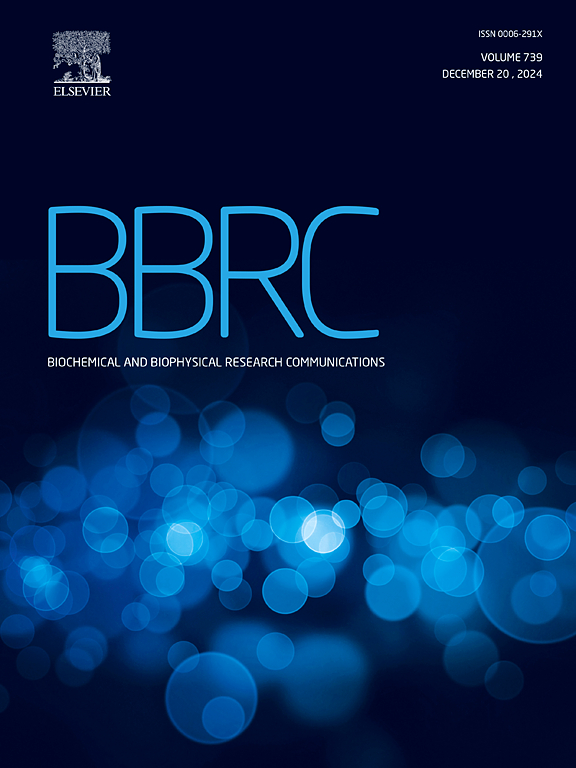增强DOX/GO/Fe3O4纳米材料在胶质母细胞瘤中生物相容性的间接途径的鉴定:基因网络建模和途径分析
IF 2.5
3区 生物学
Q3 BIOCHEMISTRY & MOLECULAR BIOLOGY
Biochemical and biophysical research communications
Pub Date : 2025-05-26
DOI:10.1016/j.bbrc.2025.152077
引用次数: 0
摘要
多形性胶质母细胞瘤(GBM)是最常见的中枢神经系统原发性恶性肿瘤。常规治疗包括最大限度的安全手术切除联合放化疗。材料和方法本研究利用Cytoscape分析了胶质母细胞瘤细胞系样品中氧化石墨烯/氧化石墨烯/氧化石墨烯/氧化石墨烯/氧化石墨烯/氧化石墨烯/氧化石墨烯/氧化石墨烯处理24小时的基因网络,以确定参与细胞凋亡的关键基因簇和枢纽基因。Real-time PCR检测游离DOX和负载DOX的GO/Fe3O4 (DOX/GO/Fe3O4)处理的A-172细胞中Casp3、Bcl-2和BAX基因的表达情况。结果测定游离DOX和DOX/GO/Fe3O4的IC50值分别为80 μg/mL和40 μg/mL。实时PCR分析显示,DOX/GO/Fe3O4和游离DOX均上调了A-172细胞中Casp3和Bax基因的表达,而Bcl-2的表达变化很小。使用NetworkAnalyst的“Mapping Overview”进行的生物信息学分析表明,miR-92a-2-5p是预防心肌损伤和增强DOX/GO/Fe3O4在GBM中的生物相容性的潜在治疗靶点。此外,癌细胞的情况与胚胎细胞相似,参与产热(miR-143)、血管内皮细胞的吸收、血管生成(miR-135ab/135a-5p)、轴突再生(mir -7/ 7ab)、昼夜节律、衰老、氧化应激、线粒体功能障碍和神经炎症的调节。结论生物信息学分析表明,自噬调节纳米材料及其掺入纳米复合物可增强DOX/GO/Fe3O4的生物相容性。纳米复合物的pH敏感性延长了药物在GBM中的暴露时间,用外磁场靶向GBM是治疗GBM的一种很有前途的方法。本文章由计算机程序翻译,如有差异,请以英文原文为准。
Identification of indirect pathways enhancing the biocompatibility of DOX/GO/Fe3O4 nanomaterials in Glioblastoma: Gene network modeling and pathway analysis
Background
Glioblastoma multiforme (GBM) is the most common primary malignant tumor of the central nervous system. Conventional treatment includes maximal safe surgical resection combined with radiotherapy and chemotherapy.
Materials and methods
This study analyzed gene networks to identify key gene clusters and hub genes involved in apoptosis using Cytoscape in Glioblastoma cell line samples treated with GO/Fe3O4 and DOX/GO/Fe3O4 for 24 h. The cytotoxicity of DOX on A-172 cells was assessed using the MTT assay. Real-time PCR was used to evaluate the expression of Casp3, Bcl-2, and BAX genes in A-172 cells treated with free DOX and DOX-loaded GO/Fe3O4 (DOX/GO/Fe3O4).
Result
the IC50 values for free DOX and DOX/GO/Fe3O4 were determined to be 80 μg/mL and 40 μg/mL, respectively. Real-time PCR analysis revealed that both DOX/GO/Fe3O4 and free DOX upregulated the expression of Casp3 and Bax genes, with minimal changes observed in Bcl-2 expression in A-172 cells. Bioinformatic analysis using NetworkAnalyst's "Mapping Overview" indicated that miR-92a-2-5p is a potential therapeutic target for preventing myocardial damage and enhancing the biocompatibility of DOX/GO/Fe3O4 in GBM. Furthermore, conditions of cancer cells showed similarities to embryonic cells, with involvement in thermogenesis (miR-143), absorption by vascular endothelial cells, increased angiogenesis (miR-135ab/135a-5p), axon regeneration (miR-7/7 ab), and regulation of circadian rhythm, aging, oxidative stress, mitochondrial dysfunction, and neuroinflammation.
Conclusion
Bioinformatic analysis suggests that autophagy-regulating nanomaterials and their incorporation into nano-complexes can enhance the biocompatibility of DOX/GO/Fe3O4. The nanocomplex's pH sensitivity prolongs drug exposure in GBM, and targeting GBM with an external magnetic field presents a promising approach for GBM treatment.
求助全文
通过发布文献求助,成功后即可免费获取论文全文。
去求助
来源期刊
CiteScore
6.10
自引率
0.00%
发文量
1400
审稿时长
14 days
期刊介绍:
Biochemical and Biophysical Research Communications is the premier international journal devoted to the very rapid dissemination of timely and significant experimental results in diverse fields of biological research. The development of the "Breakthroughs and Views" section brings the minireview format to the journal, and issues often contain collections of special interest manuscripts. BBRC is published weekly (52 issues/year).Research Areas now include: Biochemistry; biophysics; cell biology; developmental biology; immunology
; molecular biology; neurobiology; plant biology and proteomics

 求助内容:
求助内容: 应助结果提醒方式:
应助结果提醒方式:


